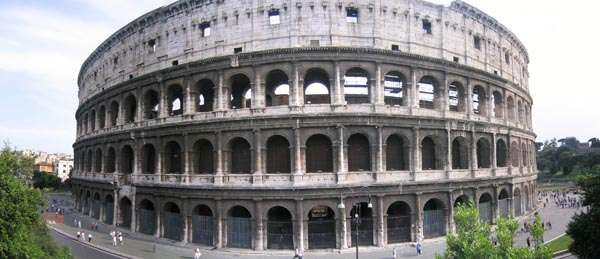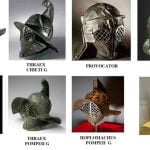Chapters
Flavian Amphitheatre, Colosseum (Amphitheatrum Flavium, Colosseum) is a huge oval-shaped structure, on which the games (ludi) were held in ancient Rome – wrestling, gladiator fights, wild animal fights and sea battles (the so-called naumachiae).
Over the centuries, the belief that Christians were murdered en masse in the Colosseum was established, which is now to be commemorated by a cross inside the building. However, this thesis is questioned by scientists. Certainly, Christians died in the arena of the Colosseum, but there was no mass murder here, as many contemporary accounts show. Executions of Christians also took place elsewhere in Rome, such as in Nero’s private circus.
Construction of the Colosseum began around 70 or 72 CE at the behest of the founder of the Flavian dynasty, Emperor Vespasian, who ordered this structure to be erected on the site of an artificial lake in the unfinished rich residence of Emperor Nero – Domus Aurea (“Golden House”). Vespasian, who came to power through a military coup, wanted in this way to win the favour of the Roman people, necessary to consolidate the acquired power. As a famous and victorious commander – the conqueror of the Jewish uprising in Judea – the emperor had large financial resources and a great mass of prisoners and slaves. Ultimately, however, Vespasian did not live to open the building, because he died in 79 CE.
The opening of the Colosseum was inaugurated in 80 CE. Emperor Titus the start of the hundred days of uninterrupted Games. At that time, several thousand animals died in the arena, groups of gladiators (about 900) fought each other, and there was also a sea battle.
Throughout history, the facility has been damaged many times. In 217 CE the Colosseum was severely damaged due to a fire that, according to Cassius Dio, was caused by lightning. The fire destroyed the wooden, upper levels of the amphitheatre. The building was not fully rebuilt until 240 CE. Further repairs took place in 250 (or 252) CE and again in 320 CE. Inscriptions on some elements of the building have been preserved, suggesting their reconstruction in the late period of the Empire. Such repairs were carried out during the reign of Emperor Theodosius II and Valentinian III (probably due to the earthquake that occurred in 443 CE). Further work was carried out in 484 and 508 CE, after the conquest of Rome by the barbarians.
Building
Given the building abilities of the ancients and the complexity of the design, the Flavian Amphitheatre was a huge and unusual structure. Its longer axis is 187.75 meters, the shorter axis is 155.6 meters, and the height is about 50 meters. The perimeter is 524 meters, while the area of the arena is 3,984 square meters. The Colosseum consisted of an arena, ie a wooden floor covered with a layer of sand a few centimetres (the name comes from the Latin word harena meaning “sand”). It was exceptionally large (83 by 48 meters) and perfectly visible from every place of the amphitheatre.
The arena covered an intricate underground structure called hypogeum (literally “underworld”). Little remains of the original arena to this day, but the hypogeum is still visible. The structure consisted of two levels, interwoven with many tunnels and passages. There were also cages in which gladiators were kept and animals, which were then released into the arena through special exits. There were also special platforms (hegmata) that allowed larger animals (e.g. elephants) to be brought into the arena. The whole hypogeum was filled with many mechanisms that made it possible to transport the cages to the ground level or even to immediately flood the arena with water, which was brought by a nearby aqueduct.
Around the arena, there was a podium (suggestum) that housed the Emperor’s throne and places for his family, senators, and vestals. The seats of the senators circled the emperor’s box and were often made up of chairs brought by senators. The next level (maenianum primum) was constituted by nobles (not holding the functions of a senator) and equites. Then, ordinary citizens of Rome – plebeians (plebeians) sat in maenianum secundum. This section was divided into the lower part immum – for the richer; and the upper summum – for the poorer. There were also special sectors for specific social groups: boys with teachers, soldiers on leave, foreign officials, scribes, priests and others. Marble and stone seats were intended for citizens and nobles who probably brought pillows with them. The most distant places (about 50 meters above the stage) were occupied by women, slaves and the poor. It was the so-called maenianum secundum in legneis, a sector built during the reign of Domitian, consisting of steep wooden benches. Some social groups were barred from entering the Colosseum, especially: gravediggers, actors or ex-gladiators.
So it is clear that the stands were divided according to sex and social status, which resulted from the principles of the social life of the Romans. There were 45,000 to 50,000 seats in the audience and several thousand people standing, but the venue could certainly accommodate over 50,000 people. According to the late Roman illumination “The Chronograph of 354 CE”, commissioned by the wealthy Roman Christian Valentine, the Colosseum had a capacity of around 87,000.
Viewers entered through 80 (from the ground level) numbered entrances (vomitoria), which, according to some researchers, allowed viewers to quickly leave the audience even in about 6 minutes. The service entered 4 separate communication galleries. One of them was the northern main entrance, which was reserved for the emperor and his helpers. The other three were intended for the Roman elite. Most of the original external entrances were destroyed, but to this day you can see entrances XXIII (23) and LIV (54).
In the four-storey external division, a stacking of orders was applied (the lowest storey in the Tuscan order, the second in Ionic, the third in Corinthian, and the fourth was decorated with Corinthian pilasters). The three lower storeys are connected with the structural arrangement of the arcades, the fourth storey has only small windows. From the inside, the building is five-storey. Four floors were built as a layout of rooms separated between pillars, and walls, with barrel and cross vaults. There are buffets, cloakrooms, showers, rooms for gladiators, animal cages and corridors.
In the event of rain or strong sun, it was possible to cover the entire audience with a special large, waterproof canvas (velarium), stretched with ropes. The large material covered 2/?of the arena, and the sailors from Misenum, whose temporary seat was Castra Misenatium, were responsible for its spread.
Other objects
The creation of the Colosseum and the organization of the games attracted industry to its area. Objects began to appear around the building to help with the handling of events. To the east of the Colosseum was the Ludus Magnus gladiators’ school – now only ruins remain. The building actually adjoined the amphitheatre and was connected by an underground passage that allowed for quick transport of gladiators to the arena. Ludus Magnus had his own small training arena which was itself popular with the Roman inhabitants.
There were also other gladiators’ schools in the same area: Ludus Matutinus (“morning school”) – they trained animal warriors; moreover, she was famous, among other Dacian and Gallic schools.
Nearby there was also: Armamentarium – weapons and armour storage room; Summum Choragium – machinery storehouse; Sanitarium – gladiators’ hospital; and Spoliarium – the place where the bodies of the gladiators were stripped from their armour and their bodies removed.
Interesting facts about the Colosseum |
|
Usage
The Colosseum was used to organize both gladiatorial fights and other types of shows and events. Munera, that is, gladiatorial fights, for example, were always organized by private individuals. They had a strong religious overtone and were intended to highlight the good name of the family and give prestige to its members.
Another type of game was wild game hunting – venatio. During this event, many different creatures passed through the arena, for example from Africa, Eastern Europe and the Middle East. The traders brought rhinos, hippos, elephants, giraffes, aurochs, bison, lions, panthers, leopards, bears, Caspian tigers, crocodiles and red-skinned ostriches. Fights and hunts were often located among elaborate vegetation and structures. Such events were extremely rare. It is believed that in 107 CE Emperor Trajan organized a big 123-day Games to celebrate the conquest of Dacia where 11.000 animals and 10,000 gladiators were shown.
In the early days of the Colosseum (according to ancient historians) there was naumachiae (better known as navalia proelia), or naval combat. Sources indicate that in 80 CE there was the inauguration of this type of show commissioned by Tytus. At that time, the arena of the amphitheatre was flooded, and specially trained horses and bulls were released into the water to compete with each other. There was also to be a sea battle between the Greeks, Corinthians and the inhabitants of Corfu. This event, however, is still subject to criticism by many historians who claim that there could not be enough space in the arena for warships and that the arena was waterproof. However, it was recognized that the Romans did not have any problems filling the arena with water.
Another type of event was sylvae, that is, reconstructions of natural scenes. Painters, technicians and architects were to construct forest simulations with real trees and bushes planted in the arena. Animals were released into such an environment that the viewers could admire. Such a show was aimed at showing the natural habitats of animals or mapping events in mythology. Sylvae were also an occasion to carry out executions in which the main character of the story – played by a convict – was killed in an elaborate and cruel (though possible) way, in order to play an important scene from the myth.















